Between 1967 and 1969 Bruce Nauman made a set of films and videos of himself performing monotonous actions in his studio. These works fall into two groups. The first is a set of 16mm films, typically each around ten minutes in length, made in San Francisco in a studio in Mill Valley that Nauman sublet from his former teacher William T. Wiley in the winter of 1967–8.1 The second is a set of videotapes, each around sixty minutes in length, made with a Portapak video camera in a studio in Southampton, New York, over the following winter, 1968–9.2 In these films and tapes, all recorded in black and white, Nauman performs various mundane and repetitive actions: stamping, jumping, playing the violin, bouncing balls, but mostly walking. In some cases Nauman explores the rhythms of walking, stamping out a set of changing tempos; in some he explores gait, shifting his weight from leg to leg in an exaggerated manner; in some his walking is more mechanical, each step broken down into its constituent parts; and in every case his walking is enclosed within the confines of taped lines, a corridor, or the studio itself. When exhibited, these works are played on a loop, making it easy to imagine that Nauman has been pacing forever. Indeed, there is something sinister behind the apparent banality of the repetitive actions.
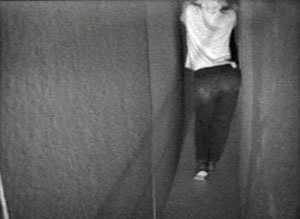
Fig.1
Bruce Nauman
Walk with Contrapposto 1968 (still)
Video with sound
60 min
Los Angeles County Museum of Art
© Bruce Nauman
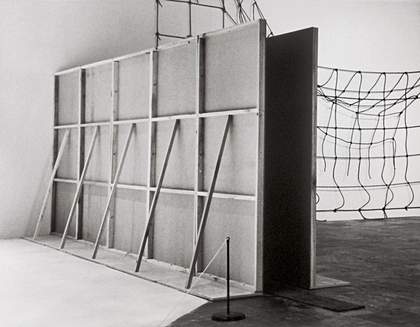
Fig.2
Bruce Nauman
Performance Corridor 1969
Wallboard and wood
Solomon R. Guggenheim Museum
© Bruce Nauman
This exploration of the walking body in Nauman’s recorded performances led directly to the display of his first corridor installation, since the prop used in the video Walk with Contrapposto 1968 (fig.1) became Performance Corridor 1969 (fig.2). In the later corridor pieces Nauman created complex arrangements of narrow spaces, variously involving video recording and playback devices, intensely coloured light, padded walls and cage-like structures in order to create rigorously managed experiences that placed the participant in a condition of physical and sensorial confinement (see, for example, Changing Light Corridor with Rooms 1971, Tate AR00044). In presenting such installations to his audiences, Nauman invited them to walk too, to pace confined spaces as he had done.
In the late 1960s many artists began to use walking in their work as an expansive gesture. Richard Long trampled a line in a field (A Line Made by Walking 1967, Tate P07149), Robert Smithson took a walking tour around a New Jersey town (A Tour of the Monuments of Passaic, New Jersey 1967), Michelangelo Pistoletto walked a huge ball of newspaper around the streets of Turin (Walking Sculpture 1967), Walter de Maria created a drawing as long as a walk (One Mile Long Drawing 1968), and Nancy Holt photographed painted way markers on Dartmoor (Trail Markers 1969). These artists walked as a means of radically reconfiguring the mediums within which they worked – subverting traditional notions of sculptural monumentality (Smithson), rolling sculpture off its pedestal (Pistoletto), challenging the materiality of the art object (Long), extending the reach of a drawing (de Maria) or a painting (Holt). Walking became part of what the critic Lucy Lippard called the dematerialisation of the art object, as it collapsed into conceptual or performative practices that sought to challenge the structures and economics of the art institution.3
Urban theorist Francesco Careri has argued that this era marked a fundamental shift away from earlier uses of walking in art, such as the surrealist deambulation and the situationist dérive, which ‘were made as an expansion of literature into the visual arts’.4 Careri asserts that, by contrast, Richard Long’s use of walking in the 1960s, in works such as A Line Made by Walking 1969, was ‘an integral part of a more general expansion of sculpture itself’.5 So where the earlier uses of walking expanded the literary field, walking in the 1960s expanded the sculptural field. As Careri sees it, ‘through the path [i.e. through walking] different disciplines have produced their own “expansion of the field” for coming to terms with their own limits’.6 In contrast to Careri’s argument, this paper will show the ways in which Nauman used walking not to emancipate his practice, but to fold its limits back upon itself. This is evidenced both in the films and videos of the late 1960s and in the corridor works that immediately followed. While Nauman’s earliest post-graduation works of 1966–7 ‘coolly trumped’ the materiality of sculpture, as art historian Anne Wagner has argued compellingly, I will make the case that with the studio films and videos Nauman began to challenge the very idea of making artistic objects at all.7 Walking became a means of not making.
In 1988 Coosje van Bruggen, the first critic to really engage with the studio films and videos, argued that Nauman stressed ‘the artist’s isolation within the double entrapment of his studio and the frame’.8 After graduating in 1967 Nauman was left without the artistic support network he had had at college, and found himself struggling to make work, wrangling with the very idea of the artistic product. ‘That’s the thing about going into the studio to experience the quiet,’ Nauman has said, ‘all that’s there is you, and you have to deal with that. Sometimes it’s pretty hard’.9 As we watch the artist pacing his studio for hours at a time, this sense of isolation is palpable, as his footsteps echo around the empty space. In this paper I want to suggest that this aesthetic of confinement and entrapment goes beyond reflecting Nauman’s own personal struggle with the artistic production of objects, to reflect wider societal concerns about production and productivity in capitalist society.
Exercise as control
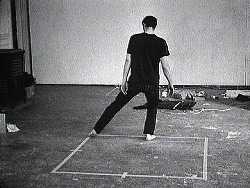
Fig.3
Bruce Nauman
Dance or Exercise on the Perimeter of a Square (Square Dance) 1967–8 (still)
16 mm film on video
8 min 24 sec
© Bruce Nauman
In the ten-minute film Dance or Exercise on the Perimeter of a Square (Square Dance) 1967–8 (fig.3) Bruce Nauman, barefoot and clad in a dark T-shirt and jeans, begins by standing, feet together, facing away from the camera. He is positioned in the middle of the far edge of a small square, whose outline is taped on the floor. The mid-point of each edge of the square is also marked with tape. As the tick of a metronome begins, marking the half seconds, Nauman touches each toe to a corner of the square and back to the centre again: left, centre, right, centre, left, centre, and so on until he has completed sixty steps (taking a minute). He quickly swaps to the left-hand edge of the square, facing outwards, and repeats the process. He then does the same for the front and right-hand edges of the square, and then goes round again, this time in the opposite direction – front, left, back, right edges – and facing inwards, always with a fixed expression of concentration. When each permutation of the exercise has been completed, the film ends.10
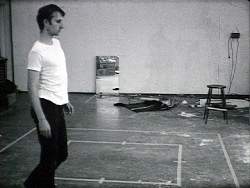
Fig.4
Bruce Nauman
Walking in an Exaggerated Manner Around the Perimeter of a Square 1967–8 (film still)
16mm film with sound
© Bruce Nauman
The title of this work makes clear the strange dichotomy at the heart of the action, which can be seen as half dance, half exercise. To dance is an aesthetic act, whereas to exercise is more functional, and contains the implication of training towards an outcome. The word ‘exercise’ connotes practice at school (the exercise book), the gym, the military parade ground, or, indeed, the prison yard. The display of another of the studio films, Walking in an Exaggerated Manner Around the Perimeter of a Square 1967–8 (fig.4), in a Nottingham police cell as part of the 2008 exhibition The Impossible Prison, placed Nauman’s walking directly within a space of law enforcement.11 In this exhibition the artist’s walking became coloured by its context, drawing attention to the very condition of incarceration that characterises all the studio-based films and videos. Taking this context into consideration, I want to explore the relationship between enforced exercise and productivity that the studio works negotiate.
The philosopher Michel Foucault has written that exercise is ‘that technique by which one imposes on the body tasks that are both repetitive and different, but always graduated’.12 Nauman’s side-to-side stepping in Dance or Exercise has just such a repetitive tenor, his footsteps measured by the tick of the metronome that rules the soundtrack. Occasionally he misses his mark on the square, or loses track of the timing, getting out of sync or miscounting the sixty steps as he gets tired. He pushes to get his steps back on track, forcing his body into the regimen he has prescribed for himself. Exercise is discipline.
Tracking the changes in approaches to the body within the penal system, Foucault marked an historical shift that took place during the Enlightenment, away from explicit punishment of the body through practices of torture, to punishment through control of the body within the prison system. Where torture was predicated upon spectacle and representation, that is, making a public example of the criminal using techniques that displayed the nature of his crime as ‘signs’ (a thief would have his hand cut off, for example), the prison hid the criminal from view, operating a system of correction and reform. Foucault writes:
Exercises, not signs: time-tables, compulsory movements, regular activities, solitary meditation, work in common, silence, application, respect, good habits. And, ultimately, what one is trying to restore in this technique of correction is not so much the juridical subject … but the obedient subject, the individual subjected to habits, rules, orders, an authority that is exercised continually around him and upon him, and which he must allow to function automatically in him.13
The prison system, then, unlike punishment by torture, aimed (and aims) to produce economically useful individuals through the regulation of their bodies, so that ex-convicts could operate productively within industrial society. Physical exercise and labour formed a central part of the organisational structure of the prison, used as a means to control the body of the inmate, and so, as it was understood in the early days of the prison system, to inculcate obedience in his soul.
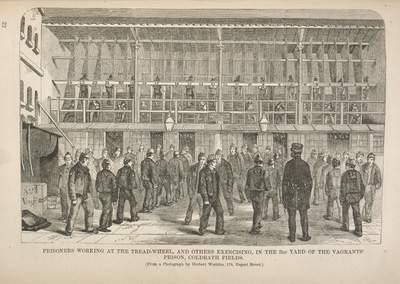
Fig.5
‘Prisoners Working at the Tread-Wheel, and Others Exercising, in the 3rd Yard of the Vagrants’ Prison, Coldbath Fields’ engraved from a photograph by Herbert Watkins
Reproduced in Henry Mayhew and John Binney, The Criminal Prisons of London and Scenes of Prison Life (1862)
Museum of London
In practice exercise could frequently mean walking, in chain gangs, in circles around the exercise yard, or on a treadmill (fig.5). The treadmill, or tread-wheel, used in many English and some American prisons in the nineteenth century, looked something like a water wheel, with steps around its circumference that allowed the prisoner to turn it by walking. Each prisoner was segregated into a narrow compartment (about two feet wide) to prevent interaction with his fellow inmates. An 1862 account of one such wheel in Coldbath Fields prison in London reads:
All the men work with their backs toward the warder, supporting themselves by a hand-rail fixed to the boards at the back of each compartment, and they move their legs as if they were mounting a flight of stairs; but with this difference, that instead of their ascending, the steps pass from under them, and, as one of the officers remarked, it is this peculiarity which causes the labour to be so tiring, owing to the want of a firm tread.14
While some tread-wheels were designed to pump water or grind grain, many were entirely unproductive, with inmates walking thousands of vertical feet in a day, simply ‘grinding the wind’ as they put it.15 One of the central problems of productive labour within prisons was that it took work away from those on the outside, leading to unemployment, and since the prime purpose of labour within the walls of the prison was not in fact material outcome, but discipline, it did not matter whether the tread-wheel milled grain or thin air. Foucault notes that these tread-wheels, though they provided no material product, ‘provided a disciplinary mechanisation of the inmates’: the product, then, was what Foucault termed the ‘docile body’ of the inmate, that is, an obedient and economically useful body whose labour was likely to be productive in the wider world after release.16
As with the prison tread-wheel, in Nauman’s studio films and videos the input of effort does not equate in any way with the minimal output. The expenditure of energy through walking produces no end product, no artwork in the material sense of the term. These works, as noted above, are normally read in relation to their place in Nauman’s career: the recent graduate explores his place in the studio, and does so without the means to purchase sculptural materials to make object-based artworks. While Nauman has no materials for the production of objects, he nevertheless forges a link between work, in the form of labour or bodily exertion, and artwork. This implies that bodily effort, or more precisely bodily training, is considered an output in itself, a step towards Foucault’s ‘docile body’. The artist reveals that the production of an object, however immaterial, always also produces a trained body. Carefully following the structured patterns of Dance or Exercise and Walking in an Exaggerated Manner, Nauman trains himself as the output of his own artistic experiments.
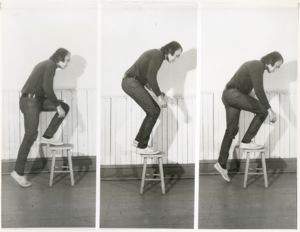
Fig.6
Vito Acconci
Step Piece 1971
Akron Art Museum
© Vito Acconci
Parallels can be drawn here with Vito Acconci’s Step Piece 1970 (fig.6), which the artist performed in his apartment every morning at 8am for four months, stepping on and off an eighteen-inch stool ‘at a rate of thirty steps a minute; each morning, I continue the activity as long as I can do it without stopping.’17 Over the course of the training, which notably resembles the exercise of the prison tread-wheel, Acconci improves: in the month of April, for example, he starts by being able to perform the task for a duration of seven and a half minutes, and ends the month with a time of twenty-six minutes and ten seconds. Each time is meticulously recorded on a typed-up progress report, offering a veneer of administrative rigour to the task, redolent of the ‘aesthetic of administration’ that art historian Benjamin Buchloh saw in much conceptual art of this era.18 Acconci seems incarcerated within his own system, a system predicated on the kind of precisely mapped exercise that might be found in an institutional timetable. Through their rigorous regimes, both Acconci and Nauman demonstrate an almost masochistic control of the self. Nauman operates a strange prison, in which he is both inmate and guard, using exercise as a means of self-discipline. Foucault writes that in the prison system: ‘The training of behaviour by a full time-table, the acquisition of habits, the constraints of the body imply a very special relation between the individual who is punished and the individual who punishes him. It is a relation that not only renders the dimension of the spectacle useless: it excludes it.’19
As Nauman further closes the gap between punished and punisher, the very unspectacularity of such a closed system is bound into his films in their incessant banality and repetition. Watching these films is not tied to spectacle, but rather to the observant eye of surveillance. The camera plays the role of overseer, with the viewer playing accidental witness to, and perhaps arbitrator of Nauman’s activities. These nuances shall be explored in greater depth in the final section of this article, but here it is important to note that the camera captures the artist operating a system of repetitive and regimented discipline upon himself. Nauman’s exercise echoes many of the characteristics of state incarceration, operating as a form of solitary confinement, which is used in systems of correction as a means to ‘rearrange not only the complex of interest proper to homo oeconomicus, but also the imperatives of the moral subject’, as Foucault has it.20 The duration of the exercise and the loop of the tape – Nauman is still there, still pacing – seem to be a form of ‘doing time’, as if the artist has sentenced himself to ‘Time, the operator of punishment’.21 In the absence of the institutional structures of the art school, it is as if Nauman created his own form of self-appointed institution in an attempt to re-create the sense of the supervised structure he had lost. This deepens the usual reading of the films as coping strategies of the recent graduate who had lost the net of institutional support: the works record the disciplined structures that the artist had made for himself to operate within.
It is important to note, then, that Nauman’s exercises are not only physically practised within a confined space, but also echo the historic functions of systems of confinement as producers of ‘docile bodies’. Foucault wrote that the docile body was ‘something that can be made; out of formless clay, an inapt [sic] body, the machine required can be constructed; posture is gradually corrected; a calculated constraint runs slowly through each part of the body, mastering it, making it pliable, ready at all times, turning silently into the automatism of habit’.22 Such metaphors of material manipulation, of clay and of pliability, pepper Foucault’s text, and render the docile body itself a kind of sculptural output. While Nauman was resisting the production of artistic objects in these films and videos, he nevertheless plies his own body as a kind of sculptural product in itself, shaped out of ‘formless clay’.23
Idleness and productivity
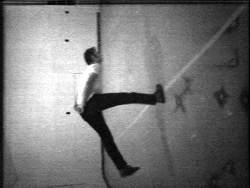
Fig.7
Bruce Nauman
Slow Angle Walk (Beckett Walk) 1968 (still)
Video with sound
60 min
© Bruce Nauman
This tangled web of allusions to processes of productivity is most noticeably at play in two of the video works: Slow Angle Walk (Beckett Walk) 1968 (fig.7) and Walk with Contrapposto 1968 (fig.1). The former video overtly references Samuel Beckett, whose plays and novels Nauman first encountered in 1966–7. In Slow Angle Walk there is particular allusion to the eponymous characters of Beckett’s novels Molloy (1951) and Watt (1953) in the peculiar stiff-legged gait and pattern of movement that the artist adopts, which he has described as ‘a tedious and complicated process to gain even a yard’.24 Hands clasped behind his back, Nauman keeps his legs straight, and balances on one foot for several seconds as the other leg sticks out behind him. To take a step, he swings his back leg to the front, keeping it straight all the while, holding it in front of him for a moment, and then falling onto it with a clunk, allowing the other leg to jut out behind him for the process to begin again. In Beckett’s novel Molloy describes his own walking patterns at length, his attempts at negotiating the pain and stiffness in his legs, and the difficulty of having one leg shorter than the other: ‘But I couldn’t. What? Bend it. For how could I bend it when it was stiff? I was therefore compelled to work the same old leg as heretofore, in spite of its having become, at least as far as the pain was concerned, the worse of the two and the more in need of nursing.’25 Molloy finds that he is able to use the camber of the road to even out the length of his legs, so making his progress easier. Likewise, Nauman finds a solution to the problem of walking without bending his legs, swinging them through on each step. As he does so his direction changes, the pattern adopted resembling, but not precisely replicating, that performed by Watt in Beckett’s novel:
Watt’s way of advancing due east, for example, was to turn his bust as far as possible towards the north and at the same time to fling out his right leg as far as possible towards the south, and then to turn as far as possible towards the south and at the same time to fling out his left leg as far as possible towards the north … and so on, over and over again, many many times, until he reached his destination and could sit down.26
Nauman makes a deft approximation of Watt’s ‘funambulistic stagger’, changing direction on every step to form a pattern around the floor of the studio.27 Following Beckett’s long and tediously thorough descriptions of the gaits of his characters, Nauman also performs his own walk with monotonous precision. The everyday action becomes laboured and stilted: slow, circuitous progress is made, and nothing much seems to be achieved. This is a deliberate means of not producing an object.
In Walk with Contrapposto, such unproductivity is figured through the confined space of the walk: Nauman paces back and forth, never reaching a destination. Indeed, as he walks away from the viewer, the artist aptly walks into the dead end of the corridor. In this respect the work echoes Robert Morris’s Passageway 1961, a curving corridor that narrows at its end. Here the participant is drawn into the walls of the installation, walking towards nothing, then, according to Morris, leaves graffitti on the walls summing up the futility of the journey: ‘Fuck you too’.28 Likewise, Nauman perversely wastes effort walking towards a dead end, performing a gait that takes significantly more effort than a straightforward walk, as he sways his hips from one side to the other. Indeed, for performance theorist Richard Schechner ‘non-productivity’ is what characterises all performative genres from play and sport to ritual and theatre.29 Nauman’s performance brings this into sharp relief, as no economic purpose or object seems to amount from his walk.
This emphasis on repetitive idleness in Slow Angle Walk and on unproductivity or futility in Walk with Contrapposto is provided with a counterpoint in the way that Nauman essentialises his gait in both videos. Through the performance of a broken or split gait Nauman imitates the chronophotograph, ironically recalling its use as an instrument by which to find efficient bodily movement in the name of industrial progress. Chronophotographer Étienne-Jules Marey, for example, worked closely with engineer Charles Fremont to photograph sequences of blacksmiths and other tradesmen at work in order to study the minutiae of bodily movement and tool use.30 Such studies allowed better tools, as well as better means of using them, to be developed. Nauman’s stilted steps in Slow Angle Walk and Walk with Contrapposto become analogues for the various uses of chronophotography in studies of industrial efficiency. Yet, unlike in these industrial uses, Nauman’s walks have no results: no products made, no destinations reached. Furthermore, the carefully drawn diagram that lays out his route in this work suggests an architectural plan or perhaps a production line, with arrows indicating the direction of travel. Yet these allusions to mechanical productivity do not undercut the slowness and idleness of Slow Angle Walk, nor the dead-end set-up of Walk with Contrapposto, but only heighten their inefficiencies, since Nauman’s gaits are in no way efficient: his mechanically chronophotographic body seems an ironically unproductive antidote to its historical counterparts, an escape from the ideology of progress. Indeed, Nauman just seems to be ‘grinding the wind’ and the idea that the only product of these videos is the artist’s own ‘docile body’ becomes all the more compelling.
In this reading the films and videos themselves might be seen as by-products of a process, a kind of waste that is skimmed off, like the layer on molten metal in the sculptural casting process. Indeed, Nauman always considered the filming process as a subsidiary necessity. As he said: ‘When I was living in San Francisco, I had several performance pieces which no museum or gallery was interested in presenting. I could have rented a hall, but I didn’t want to do it that way. So I made films of the pieces, the bouncing balls and others.’31 It is clear here that the performing body was always Nauman’s central concern, with the act of recording being a kind of after-thought. Such an understanding of the studio works as by-products of a process of performance, I argue, makes sense of their intractability: they are challenging to watch precisely because they are not made to be watched, at least not from beginning to end in a single sitting. Indeed, as is argued in the next section, viewing them is more akin to watching surveillance footage than to watching a linear or narrative-based moving image work. The studio works are a by-product of Nauman’s system of discipline and surveillance.
Yet, just as the by-products of manufacture are often recuperated into the systems of capitalism as products in themselves, so too are the studio works.32 Although figuratively representing unproductive labour, the studio walks are not actually unproductive, since the activities resulted in artworks, the films and videos themselves, which gradually became operative within a capitalist system. This recuperation complicates a reading of the studio works that might see them as a means of circumventing the art market. Like the exercises of penal servitude analysed by Foucault, Nauman’s exercises produce above all the docile, disciplined body of the artist himself, with the films and videos as a kind of excess of this process, which, like many waste products within capitalism, are eventually recouped. Nauman’s films are not direct protests against capitalist efficiency, but rather reveal the systems by which the body is controlled and coerced into docility, and hence production.
Closed circuit walking
As we have seen, Nauman adopted video for recording his performances in the studio and went on to use it in his corridor pieces. In these installations, I will argue, Nauman used video to turn the logic of Foucauldian docility and productivity, with which he had bound himself, upon the spectator. Before he worked with video, Nauman’s ‘only real familiarity with it was seeing it in store windows – you know, a camera on the sidewalk and you see pictures in the store window’.33 What Nauman describes here would have been an early example of closed-circuit television (CCTV), and the artist’s awareness of it in this urban, pedestrian context came to bear on the way in which he used it in his work. Indeed, Nauman was making these video works concurrently with the first installation of video surveillance in US cities: from 1968 onwards CCTV was installed across public places with increasing frequency into the 1970s and 1980s.34 His early adoption of the medium marks his video work very specifically as a symptom of its era. The question remains, then, what relationship exists between Nauman’s use of video and his interest in systems of control and coercion?
The gallerist Leo Castelli purchased a Sony Portapak video camera in 1968 when they first became commercially available in the US, then for around $2,000, and lent it out to artists including Richard Serra, Keith Sonnier and Bruce Nauman. The loan of this machine led to an intense period of video making for Nauman, a chance to experiment with its capabilities beyond those afforded by film. He began to take advantage of the flexibility of the video camera to record at different orientations, recording Slow Angle Walk (Beckett Walk) on its side, Stamping in the Studio from a high angle and Pacing Upside Down from a high angle and upside down. To the present-day viewer these high camera angles suggest the appearance of CCTV footage. In Stamping in the Studio and Pacing Upside Down Nauman becomes the subject of his own surveillance, with an impersonal eye viewing him from overhead. The fixed camera position, indifferent to Nauman’s location in the studio as he moves in and out of shot, particularly reflects the nature of surveillance footage. Nauman’s camera seems almost incidental, capturing actions in the studio that would seemingly take place whether they were filmed or not. Like CCTV footage, which is watched to identify behavioural differences in the surveilled subjects, which could in turn amount to criminal activity, Nauman’s studio videos are watched in a manner that attends only to occurrences outside the norm, that registers minute differences within the endless cycles of sameness. As a viewer, one is drawn towards an exhausting vigilance: since the artist traces repetitive patterns in the form of rhythms and gaits, one becomes attuned to spotting slippages and mistakes, and all the while struggles to remain alert to such things, since they are the only points of interest offered.
In the corridor installations that followed Nauman’s studio pieces, the artist fully exploited the inherent characteristics of video, turning them upon whoever might walk between the narrow walls in a bid to control him or her. While the earliest corridor, Performance Corridor 1969 (fig.2), provided a restricted space for the participant, Nauman felt that it still offered too much latitude for individual performance, saying ‘it was very hard for me to present it without any particular instructions, because I felt I didn’t want people to make their own performance. I wanted to control the situation’.35 The introduction of video, then, allowed him to bind the participant’s experience further, in a way that echoed the strictures imposed upon the artist’s own body in the studio works.
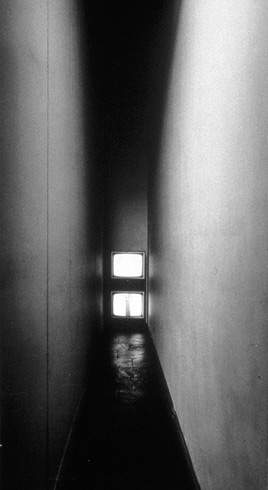
Fig.8
Bruce Nauman
Live-Taped Video Corridor 1970
Wallboard, video camera, two video monitors, videotape player, videotape
Solomon R. Guggenheim Museum, New York
© Bruce Nauman
In Live-Taped Video Corridor 1970 (fig.8), for example, the participant sees two stacked video monitors before her, at the end of a long passage. The bottom monitor shows a pre-recorded videotape of the empty corridor, while the top monitor shows a live image of the participant filmed by a camera mounted above the entrance to the corridor, facing down its length. This seemingly simple set-up has a disorientating effect upon the viewer as she walks towards the monitors. On the lower screen her presence within the corridor is denied, while the upper screen places her in a loop between voyeur and viewed: as she walks towards the monitor, her image becomes ever more distant, and she is alienated from it, watching her retreating back as if it belongs to someone else. Nauman notes, too, that he used a wide-angle lens for this work ‘so that you were removed from yourself, sort of doubly removed … as you walked, because the wide-angle lens changed the rate that you [were] going away from the camera … as you took a step, you took a double step with your own image’.36 While this work embodies the kind of entrapment that has been emphasised throughout the paper, it also promotes a splitting of subjectivity. The subject in Live-Taped Video Corridor will continue to walk towards her image while knowing that she can never reach it; she will continue to look at her image, while feeling removed from it. There is a rift, then, a division of the self between the role of participant and the role of viewer, between the experience of walking through the space and seeing oneself walking through it as detached from lived experience. The corridor is activated by the walking body, which is then made strange to its owner, as it seems to be under the control of an unknown ‘other’ rather than that of the subject herself.
Nauman emphasised that in creating such works he never liked ‘to leave things open so that people feel they are in a situation they can play games with’.37 Unlike artists such as Allan Kaprow or Hélio Oiticica (to pick only two of many examples) who had been making playfully participatory pieces since the late 1950s in which the subject could direct the course of his or her involvement within loosely defined boundaries, Nauman sought to narrow the field of possibility so that each participant would have a very specific and carefully managed encounter in which his or her behaviour would be subtly manipulated. The critic Peter Plagens has observed that, put in extreme terms, Nauman is ‘the lab scientist and we’re the rats’.38 We become the subjects of the artist’s experiments, as we are placed under the same tests of endurance and frustrating repetition that the artist faced in his studio. Although participation is always voluntary and doors are never literally locked, Nauman’s experiments nevertheless reveal his preoccupation with the degree to which carefully managed parameters can create specific experiences and forms of behaviour. It was noted above that Nauman created a form of self-appointed institution in his studio-based films and videos. In the corridors this sense of institutional control is passed on to the participant: do we obey because of the codes of practice of the art institution? Are we afraid of revealing our lack of savoir-faire within the gallery? Or is something darker at work in our obedience to the parameters of the piece?
The Nauman scholar Janet Kraynak has characterised the experience of the corridors as a form of ‘dependent participation’. Rather than offering a means of activating the body of the viewer, she argues instead that Nauman incarcerates the body physically, but also through means of submission to the ‘laws’ of the artwork. For Kraynak, such tenets fundamentally ‘question one of the stakes upon which much progressive sculptural work of the sixties turned: namely, the possibility (and benefits) of direct experience’.39 In a society in which interactivity is so often seen as a beneficial goal in its own right, Nauman’s corridors and installations, Kraynak attests, bear a ‘cautionary tale’ against ‘participation as a panacea’.40 Yet I want to add that, more than this, the corridors reveal a subject who cannot escape participation in capitalist society, who, like Nauman in the studio works, is locked within repetitive exercises that produce ‘docility’, and is therefore trapped within a system of contribution and production whether she seeks it or not.
Art historian Rosalind Krauss draws comparisons between Nauman’s corridors and the experience of walking through contemporary urban space. In particular it is the introduction of video into the corridor pieces that changes the way in which these works operate: their (modernist) architectural aspect, she argues, lies in their adoption of the promenade, ‘archi-speak’ for the movement of bodies through the spaces of buildings (she gives the example of Frank Lloyd Wright’s spiral ramp at the Guggenheim Museum in New York). When cameras and video monitors are introduced, Krauss points out, the architectural dynamic shifts, placing the viewer/participant under surveillance in an echo of ‘office buildings or apartment complexes, within which televisual security measures are on constant alert’.41 This shift, I would add, is a move from modernist to postmodernist architectural spaces, a move from the whole to the fragmented that also comes to reflect upon the subject that occupies such spaces. Surveillance fragments the subject, causes her to look over her shoulder, to guard herself against that ever-present feeling that she is being watched.
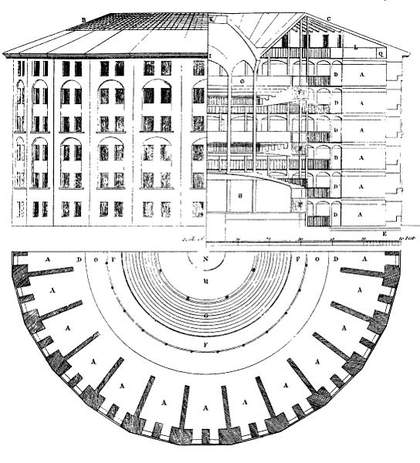
Fig.9
Willey Reveley
Elevation, Section and Plan of Jeremy Bentham’s Panopticon Prison 1791
Reproduced in Jeremy Bentham, The Works of Jeremy Bentham, vol.4, 1843, p.172
For Foucault, this subjective splitting has its origins in the societies of surveillance established in the nineteenth century. He analysed Jeremy Bentham’s Panopticon (fig.9) as the ideal architectural form for the surveillance of multiple bodies, not only in prisons, but also in hospitals, asylums, workhouses and schools. The building comprises a ring divided into cells and a central tower, from which a single guard can survey every cell. Each cell occupies the entire width of the ring, with bars on the front and a window behind rendering the inside of the cell entirely visible – there are no shadows in which to hide. Foucault notes the impressive simplicity and efficiency of such a model: ‘No need for arms, physical violence, or material restraints. Just an observing gaze that each individual feels weighing on him, and ends up internalising to the point that he is his own overseer: everyone in this way exercises surveillance over and against himself. An ingenious formula: a continuous form of power at practically no cost!’42 This not only bears upon the architectural form of the Panopticon, but also on a society built upon its mechanisms. Foucault shows at length how European and American societies established a form of panopticism in the nineteenth century, so that power was no longer centralised upon a single individual (such as a monarch), but was dispersed throughout the population, among the machinery of the state, multi-centred and ubiquitous.
Although Foucault does not bring this model right up to date, one can begin to see how it is intensified by urban camera surveillance, the monitoring of internet use, the state collection of personal data, and, most recently, voluntarily displaying one’s life for scrutiny through various social media platforms. Indeed, for philosopher Gilles Deleuze the operative systems of ‘disciplinary societies’ identified by Foucault (‘interiors’ in the form of prison, hospital, factory, school, family), were replaced in the late twentieth century by ‘societies of control’, which are much more nebulous and far more penetrating. In a society of control, Deleuze writes, ‘the corporation has replaced the factory, and the corporation is a spirit, a gas’.43 The shift from discipline to control, from a capitalism of production and property in the nineteenth century, to one of services and stocks in the twentieth, can be mapped with machines: a move from the mechanical to the digital. Deleuze notes that such a shift towards the digital homogenises spaces in which discipline was once enclosed (prison, hospital, school), so that control becomes all-pervasive. He wrote (with striking prescience in 1992):
Félix Guattari has imagined a city where one would be able to leave one’s apartment, one’s street, one’s neighbourhood, thanks to one’s (dividual) electronic card that raises a given barrier; but the card could just as easily be rejected on a given day or between certain hours; what counts is not the barrier but the computer that tracks each person’s position – licit or illicit – and effects a universal modulation.44
It is this system of technocratic surveillance, which began to emerge in the 1960s and 1970s, that Nauman distils in his corridor pieces. While in the real world CCTV recording and playback is distanced, with the viewed and viewer physically separated, in his corridors Nauman places his participant in both positions within an enclosed and self-reflexive space. The type of walking subject he describes here is paranoid and alienated, in a heightened version of the urban walker who moves through a world of watchful cameras. By voluntarily entering into one of Nauman’s installations, only to be manipulated, the participant echoes her position in a society that she both willingly colludes in, and that inevitably controls her. Having internalised the presence of surveillance the modern subject is used to operating as her own disciplinarian, acting as both surveyed and surveyor, but Nauman literalises this form. The uncanniness of these pieces, then, arises not only from the fact of seeing one’s body in an unfamiliar way (from behind, walking away etc.), but also from the shock of realisation that one is one’s own surveyor, one’s own prison guard, as Nauman is to himself in his films and videos. Nauman’s determination to ‘control the situation’ does not function, as one might expect, with the artist as the centralised overseer, but with the diffusion of that control into the subject herself. The corridors rupture the illusion of centralised control, and one is faced with the perversity of acting as one’s own disciplinarian.
As Foucault shows, control of the subject begins not with the mind but with the exercised body, and this is vital to the operation of Nauman’s prison-like installations. With their narrow walls his corridors resemble the cubicles of the tread-wheel, and with the perpetual retreat of the participant’s walking body on the video monitor (as in Live-Taped Video Corridor) they also resemble the relentless perpetuity of ‘grinding the wind’. Nauman’s installations echo the penal system as mapped by Foucault and also distil the operations of a contemporary society of surveillance, as outlined by Deleuze. Through such a distillation Nauman reveals the processes of systems of control at play in society at large: his cage-like installations become insidious structures that snare their subjects. They resonate with the experience of the modern subject, whose every step is tracked, traced and tested, so that she herself monitors and drives her own docility and productivity within a society that demands efficiency from each of its ‘participants’. One might add that such a subject is most likely bound to the structures of sedentary office culture, which in turn necessitates a need to exercise, so that an interdependent relationship between office and gym emerges as part of a system of self-disciplinary practice.45 Nauman’s work, then, in both its emphasis on the trained body as a ‘product’ created only for its own sake (which is surely the goal of the gym-goer) and its replication of cubicle-like spaces, also captures this ultimate sting in the tail, that even in our ‘down-time’ we remain tethered into a system of control that keeps us primed for the office cubicle.
Where many artists working in the 1960s used walking as a means to escape the medium and its materiality, Nauman used it to further complicate and tangle this relationship, performing walks that resist the notion that walking is emancipatory. The walking body in Nauman’s work is wrought into docility like clay through the practice of walking as exercise; docility not only means obedience, meted out through the self-disciplinary structures of surveillance, but also economic productivity, the creation of things. It is true then, that, as the critic Lucy Lippard reminds us, all attempts at escape from the institution are destined to remain only attempts, and the artist cannot simply walk away from the production of objects, nor can the subject in capitalism escape her economic role.46 Yet, in Nauman’s work, this is an entrapment that remains animate due to the artist’s awareness of his own prison. As the artist Robert Smithson wrote in 1969: ‘All legitimate art deals with limits. Fraudulent art feels that it has no limits.’47 The walker who acknowledges his limits, his entrapment, offers a resistant model in which the urgency of his work and his walk is felt through his perpetual restiveness.
